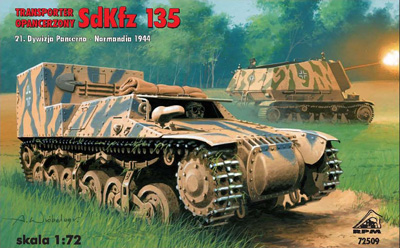A total of 240 VBCP 38L vehicles were ordered, of which nine had been delivered on 1 September 1939 and around 150 by 25 June 1940. In view of the war threat, the order was made before the prototype could be tested. Of all participants in the Battle of France, the French army would thus be the only to employ a fully tracked APC.
The vehicles were intended for the Bataillon de Chasseurs Portés, the (single) mechanised infantry battalion within the Division Cuirassée, or armoured division of the Infantry.
On 10 May they had however not yet been allocated to these units, who still used half-tracks. During May the vehicles were hurriedly taken into use by the 5e BCP and 17e BCP of the 1re DCr and 2nd DCr respectively. The 4e DCr did not receive any.
An improved model, the VBCP 39L, was created by expanding the cargo bay to carry eight passengers, apart from the two crew members. This model had no trailer and a total capacity of ten persons; extra room was found by raising the upper deck — the passenger compartment was open-topped, and constructing a more forward sloped armour glacis, contiguous with the nose section; the type thus resembled postwar APCs.

Some two hundred VBCP 39L vehicles were ordered, to replace the 38L on the production lines from the 241st vehicle onwards, but none had been delivered by June 1940, the manufacture remaining limited to a single prototype. Experimental and limited production models included tank destroyers armed with 47 mm SA 47 guns (Chasseur de Chars Lorraine) and command post vehicles; probably a Voiture de transmissions blindée sur TRC Lorraine 37 L ER prototype was produced.
In 1939 and 1940 the type had been mainly produced in the Lorraine factory at Lunéville. Early 1939 it was decided to erect a factory in a more southern location, less vulnerable to German bombing, at Bagnères-de-Bigorre. This Atelier de Bagnères had not made a single vehicle by the time of the armistice between France and Germany, but it was, like the other tractor-producing Fouga factory at Béziers, located in the unoccupied zone of Vichy France.
Limited production continued after June 1940 for a total of about 150, although military models were not officially produced. Some of these vehicles had a shortened chassis, their suspension consisting of only two bogies per side. Lorraine tractors were ostensively fitted for use in forestry and construction; in reality they constituted a clandestine armoured fighting vehicle production as they could be easily rebuilt.
The AMX factory secretly produced armoured bodies for these vehicles which were stockpiled. The type was called the Tracteur Lorraine 37 L 44. After the German occupation of the south of France in November 1942, many of these chassis were hidden. In the spring of 1944 the French resistance attacked the Bagnères factory on orders from London, the allies assuming it produced vehicles for Germany.
soviet version
after El Alamein
As the Germans themselves had not produced a similar type, the Lorraine tractors filled a requirement for fully tracked supply vehicles as Gefechtsfeld-Versorgungsfahrzeug Lorraine 37L, or Munitionstransportkraftwagen auf Lorraine Schlepper.
In July and August 1942, Major Alfred Becker directed the conversion of 170 of these vehicles into the 7.5 cm PaK40/1 auf Geschuetzwagen Lorraine Schlepper (f) or Marder I, a 75 mm equipped self-propelled anti-tank gun.
and 12 into the 10.5 cm leFH18(Sf) auf Geschuetzwagen Lorraine Schlepper.
Also an artillery observation vehicle was provided: the Beobachtungswagen auf Lorraine Schlepper, thirty of which were produced.
A single conversion entailed the fitting of a Soviet 122 mm howitzer: the 12.2 cm Kanone auf Geschuetzwagen Lorraine.
For a time it has also been assumed that a 47 mm tank destroyer conversion existed: the presumed "4.7cm Pak181 auf PanzerJäger Lorraine Schlepper (f)", based on preserved photographs that however in reality depicted the French Chasseur de Chars Lorraine mentioned above, an ad hoc conversion built in June 1940.
The Germans also employed the VBCP 38L as Lorraine 38L.


















Ei kommentteja:
Lähetä kommentti
Any explosive ammunition or empty cores, you can put in this.